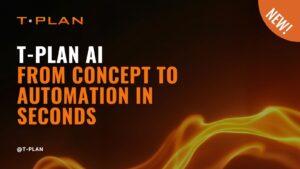In today’s world of Artificial Intelligence, a comprehensive testing approach goes beyond UI interactions and delves into validating the content accuracy across various file formats.
In this blog we’re going to show how T-Plan shines in this area of testing. Leveraging AI-powered Optical Character Recognition (OCR) technologies from Google AI and ABBYY to read and verify content from diverse sources, including documents, spreadsheets, and PDFs. This ensures that your software delivers accurate and reliable information, providing a seamless user experience both above and below the surface.
The Importance of Content Accuracy
Accurate content is critical in many applications, from financial software displaying real-time data to educational platforms offering precise information. Errors in content can lead to user frustration, financial loss, or even legal consequences. Therefore, validating content accuracy is essential for maintaining trust and delivering quality software.
How T-Plan Utilises AI-Powered OCR
T-Plan integrates advanced OCR technologies from Google AI and ABBYY, enabling it to read and interpret text from various file formats. This AI-powered approach ensures that content validation is thorough and efficient, going beyond surface-level checks to deliver comprehensive test coverage.
Case study example: Financial Report Verification
Let’s consider a practical example of how T-Plan’s AI-powered OCR capabilities can be utilised in financial software testing.

Scenario: Verifying Monthly Financial Reports
A financial software application generates monthly reports in PDF format for its users. These reports contain critical data such as income statements, balance sheets, and cash flow summaries. Ensuring the accuracy of this information is vital.
Steps in the Process:
- Document Capture: T-Plan captures the PDF file generated by the financial software.
- OCR Analysis: The captured PDF is processed using Google AI Object Text Recognition or ABBYY AI OCR. The OCR technology reads and extracts the text from the document, identifying key financial figures and statements.
- Content Validation: The extracted text is then compared against the expected data stored in the system’s database. T-Plan checks for discrepancies, ensuring that the numbers in the report match the database entries.
- Error Reporting: If any inconsistencies are found, T-Plan generates a detailed report highlighting the errors. This allows developers to quickly identify and rectify issues, ensuring the accuracy of the financial reports.
Why use AI-Powered Content Reading?
Efficiency:
Automating the content validation process with AI significantly reduces the time required for manual checks. This allows testers to focus on more complex tasks, improving overall productivity.
Accuracy:
AI-powered OCR technologies like Google AI and ABBYY are highly accurate, minimising the risk of human error in content validation. This ensures that the information presented to users is reliable.
Versatility:
T-Plan’s integration with leading OCR technologies enables it to handle a wide range of file formats, from PDFs to spreadsheets, making it a versatile tool for comprehensive testing.
Conclusion: Comprehensive Testing with T-Plan
Incorporating AI-powered content reading into your software testing strategy ensures that your application delivers accurate and reliable information. T-Plan’s integration with Google AI and ABBYY OCR technologies provides a robust solution for validating content across various file formats, offering a level of thoroughness that goes beyond traditional UI testing.
With T-Plan you can enhance the accuracy of your software, reduce the time spent on manual verification, and ultimately deliver a better user experience—ensuring that every aspect of your application is meticulously validated above and below the surface. Find out more about How AI-Powered Automated Testing Transforms Workflows.
For more information on how T-Plan can accelerate your software testing, visit T-Plan’s website or contact us.



